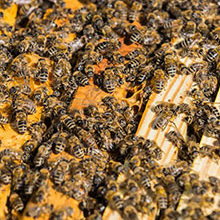A sting in the tale – could bee products yield new antibiotics?
23 October 2019

Scientists are investigating the potential for bee glue to yield new antimicrobials.
Since the discovery of penicillin in 1928, the search for new antimicrobials has mostly surrounded secondary metabolites from bacteria like Streptomyces. However, the continued emergence of multidrug-resistant bacteria and fungi is forcing researchers to search further afield in the hunt for novel antimicrobials.
For some years, Dr Margarita Gomez-Escalada from Leeds Beckett University has been investigating the antimicrobial properties of plant extracts. However, more recently her research group has become involved in the study of propolis, more commonly known as ‘bee glue’, a resinous mixture used by bees to protect the hive. It is a highly complex substance made when bees mix saliva and beeswax with exudate – such as sap and resin – from trees and other plants. Over 300 different compounds have been identified in propolis but, as the geographical location of the hive and the plants the bees visit can affect it, the composition of these compounds is highly variable. This high complexity and variation led Dr Gomez-Escalada to investigate the potential for propolis to act as an antimicrobial.
Propolis has a long history of medicinal use. There is evidence that propolis was used as far back as 350 B.C. when the Ancient Greeks used it to treat abscesses. Its use has also been recorded at other points throughout history to heal wounds and tumours. Propolis has potential benefits for infections and injuries such as minor burns, tuberculosis and Helicobacter pylori infections; however, there is insufficient evidence to properly rate its effectiveness. Dr Gomez-Escalada is hoping to fully research its potential, saying, “We are now working to understand what properties does propolis have and also hopefully find out how it works, so that we can optimise its use and exploit it to all its potential.”
Dr Gomez-Escalada is currently studying the antimicrobial and antioxidant activity of propolis from a variety of different geographical locations, hoping to match certain chemical profiles with specific antimicrobial and/or antioxidant activity. While it is still too early to report findings, Dr Gomez-Escalada said: “We hope to be able to pinpoint better the different types of activity in order to optimise use of propolis from different geographical origin.”
Dr Gomez-Escalada highlighted the importance of researching new antimicrobials, saying, “We desperately need more antimicrobial compounds with the current antibiotic resistance crisis. Old methods used for the discovery of antibiotics particularly are not as effective as they once were. So we need to look at other alternatives, and nature to me seems like the first place we should look.”
Dr Gomez-Escalada will present this work at the Antimicrobial drug discovery from traditional and historical medicine Focused Meeting on 29 October 2019 in Oxford. Her talk ‘Deciphering the biological activity of propolis (bee glue) and its constituents; what is its potential as an antimicrobial?’ will take place at 14:05.
Image: iStock/Lester120.
